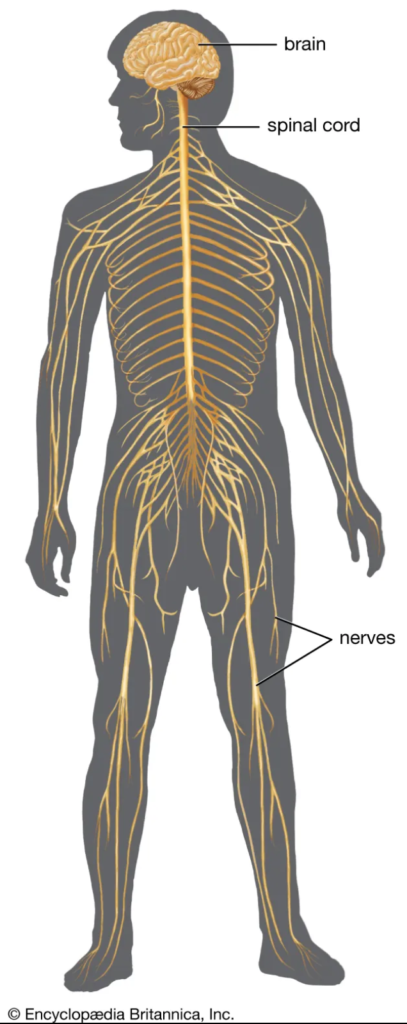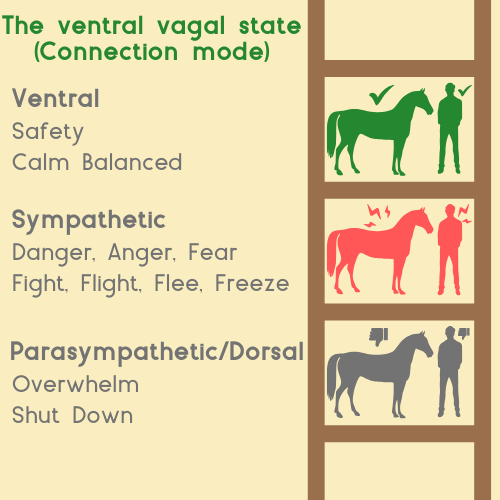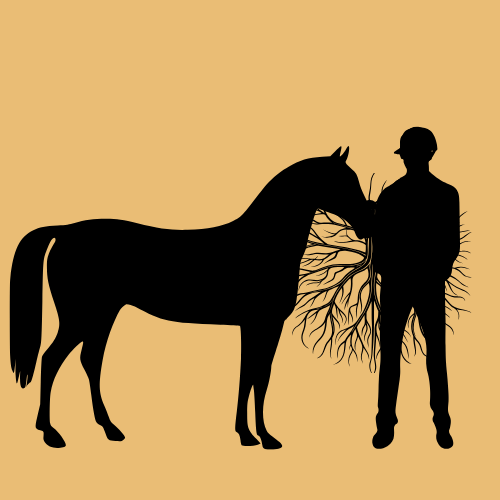Thinking about nervous systems, self-regulation and co-regulation whilst you are hanging out with your horse has many benefits. When free of judgement and emotion we can use mindfulness, being present, notice our surroundings, be aware of self, other and the two of you together.
Horses react extremely quickly to stimuli from the environment, so in effect it has a highly reactive nervous system.
The Nervous System
The nervous system enables animals and humans to orientate themselves in their environment, pick up stimuli, process them and then respond to them. Additionally, the nervous system monitors and regulates the other organ systems, such as the digestive or the cardiovascular systems.
The nervous system consists of the brain, the spinal cord and many different types of nerves.


Credit https://campus.fei.org/mod/feislideset/view.php?id=3469
Credit https://www.britannica.com/science/human-nervous-system
Polyvagal theory
The vagus nerve is called the wandering nerve because of how long it is and how far it reaches throughout the body.
- Vagus nerveThe vagus nerve is the longest cranial nerve in the body, running from the brainstem to the colon. It controls many functions, including slowing the heart rate.
- Two branches of the vagus nerve The vagus nerve has two branches, the dorsal vagal and the ventral vagal. The dorsal vagal branch is associated with a shut down state, while the ventral vagal branch is associated with a social and engaged state.
- Stress responses When faced with a threat, the body will initially try to connect with others for safety. If that’s not possible, the body will go into a fight or flight state. If that doesn’t work, the body will shut down.
- Relationship-building Some horse trainers use polyvagal theory to focus on building relationships with their horses before training.

Self regulation
Self-regulation is the ability to recognise and manage your own emotions. That means you understand if you are feeling anxious, high energy, falling asleep or low energy – this is even better if you can get yourself into the calm alert state.
If your horse is only used to you coming to the barn to “get a job done” then that is what they will expect from you! Co-regulation means finding harmony and a shared safe feeling state with the horse, where we are listening more than telling, creating responsiveness, and understanding rather than tension and reactivity.
In extreme states of arousal – when we might describe a horse or a human as being in flight, fight or ‘flooded’ (or crazy, stubborn, or ‘checked out’) – the best we can do is to create a feeling of safety. We can help each other out by providing a safe nervous system to provide a touchstone for co-regulation.
You cannot co-regulate someone else that does not trust you, you can calm yourself so the other can co-regulate with you. If there is trust, you can co-regulate the other. If you have consent to do that. If you can read the response, knows how to regulate your own out-going regulatory behaviours, if you can stop, give time to the other to adjust.
Co-regulation with a horse can help you:
- Regulate your nervous system
- Learn to feel safe
- Learn to support and soothe yourself
- Reflect on your behavior, communication styles, and functioning
- Experience unconditional positive regard
- Experience love
Here are some ways to co-regulate with a horse:
- Be with a regulated horse
- Complete activities like grooming, leading, and riding
- Receive non-judgmental feedback
- Experience validation
- Be self-regulated
- Practice pendulation and titration
- Apply polyvagal principles
You can also co-regulate with animals in general by:
- Matching your breath to a calm animal’s
- Practicing grounding techniques like stretching, meditation, and breathing exercises
- Snuggling with the animal
- Sharing your day with the animal and naming your feelings
- Playing with the animal
SET YOUR INTENTION
Before you even step out of your car, set the intention of connection. That is exactly the intention
that will help set the stage for your horse to
understand. You are surrendering to
whatever may unfold as you connect with
your horse.
Conclusion
Once your horse feels the energy shift between you, your relationship can really improve. You will notice the horse learning new skills, exhibiting more relaxation cues; yawn, blowing out nose, shaking, rolling, closing their eyes, etc.
This is a sign you are now able to hold space for your equine partner.
You should also notice a different visceral state of your own. The more time you spend with your horse co-regulating the greater improvements you will notice.

